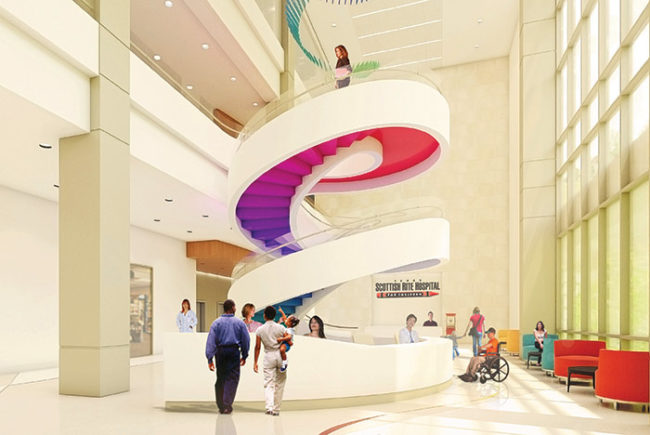 |
|
PHOTO COURTESY OF MEDSTAR HEALTH AT FEDERAL HILL MedStar Health at Federal Hill in Baltimore is a multispecialty facility that provides medical services in a patient-centered environment close to where patients live and work. |
Health systems across the country are looking to achieve adequate scale and size for a variety of reasons. In many cases, it is related to contracting strength with insurers, access to capital or driving cost-efficiencies.
For example, virtually every health system has been employing or acquiring primary care physicians or established group practices at a breakneck pace. Consequently, health systems have inherited a patchwork of facilities that may or may not meet the needs of the marketplace and typically have varied quality and a lack of branding.
This has led to a proliferation of real estate obligations for health systems that are generally managed on an ad hoc basis without a full understanding of the financial risk or how they fit into an overall market strategy for the delivery of care.
These legacy holdings also may create compliance issues by creating new relationships between hospitals and physicians. Thus, a plan that addresses legacy properties and market strategies for growth should be part of every system’s strategic initiative.
Legacy challenges
Understanding legacy properties is often challenging. However, solutions are abundant and typically multifaceted, including dispositions, consolidations, blend-and-extend on leases, master lease renegotiations or recapitalizations. These can yield savings that help to fund future market growth as well.
Developing a go-to-market plan for ambulatory services requires understanding local market conditions, competition, demand and the strategic approach to delivering care. Generally, health systems categorize their real estate into three broad categories:
Inpatient acute care. This includes medical-surgical spaces, acute rehabilitation and long-term acute care.
Historically, health systems have focused on their inpatient assets with their ambulatory investments geared toward more intense uses such as surgery or cancer centers. Generally, these also have been located on or adjacent to existing inpatient campuses.
While there is significant opportunity for improvement in care and cost efficiencies through the rationalization of acute services, decisions related to these actions often are too controversial and require major changes within medical staff to achieve success. Even in markets that are heavily over-bedded, despite a general trend toward decreasing inpatient volumes, systems have been reluctant to reduce inpatient capacity.
As cost pressures continue, health systems will need to begin making difficult decisions on facility utilization, service line consolidations and conversion to post-acute care in some of these spaces. The advent of narrow networks and systems assuming financial risk for populations should accelerate these decisions; however, it remains nascent in spite of the opportunity for both financial savings and improved quality of care. As a result, portfolio optimization primarily has been focused on ambulatory networks.
Outpatient and ambulatory care. This includes ambulatory surgery centers, freestanding emergency departments, urgent care centers, imaging centers, cancer centers and medical office buildings.
Health systems are beginning to look beyond traditional inpatient volume growth as the key driver for profitability and now are focusing on population health management. This has generated a new focus on delivering care in patient-centered, cost-effective settings. The anticipated responsibility of managing population health will require systems to emphasize the creation of long-term relationships with customers in their communities rather than simply focusing on growing inpatient service lines at their core facilities.
Many health systems are looking at how they can develop a broadly based ambulatory network that can position them to meet the challenges of population health management. The overarching goal for the development of an ambulatory network is to: provide coordinated care that is seamless to the patient, offer high-quality care, improve health outcomes and deliver care closer to where the patient lives or works.
This is forcing health systems to adapt to new perspectives, extend their capabilities beyond the hospital campus, and to rethink what, where and how they are going to grow. To do this, they need to understand what is required to manage health and how to deliver it at the community level.
Back-office space. An often-overlooked component of a health system’s real estate needs is back-office and administrative requirements. This includes administrative offices, teamwork spaces and support staff spaces.
Underutilized portions of acute care campuses often are converted for office use or are spread across wide geographies and have lost any adjacency relationships that might be helpful. Moving into vacated acute care spaces often is viewed as an inexpensive alternative to leasing other space for these uses, but often leads to a misallocation of resources and excessive square footage for the users.
These assets also may be treated differently for tax purposes, with the acute care being covered by a master trust indenture related to tax-exempt financing and the ambulatory facilities leased from third-party landlords or developers. Sometimes the acute facilities are described as core and the ambulatory facilities as noncore assets.
Developing a plan
Although many hospitals may be part of a larger system, health care still is delivered locally and regionally. This necessitates a detailed understanding of the existing portfolio to plan for the future. The key steps for creating an optimization plan include:
Discovery. This requires becoming familiar with the organizational profile, defining the scope of services and overall goals, analyzing organizational performance versus that of peers, understanding the organization’s network and defining the risks.
The discovery phase often is the most challenging part of the process. This is because real estate typically has been assembled through acquisition and, over time, good information about ownership and leaseholds has not been captured in a single spot or organized in a fashion that allows analysis.
This first phase often requires effort that includes lease abstraction, physical site visits and property evaluations. If systems go to this effort, it is wise to incorporate this information into a maintainable database that is kept up-to-date. There are numerous off-the-shelf software products available for this purpose, such as Lease Harbor LLC’s Harbor Flex and CoStar Real Estate Manager’s Virtual Premise as well as products from MRI Software and Timberline Software.
Gathering the knowledge around the legacy properties and viewing them as a portfolio as opposed to a series of individual holdings typically leads to some early conclusions around cost savings and efficiency opportunities. These quick hits can yield enough in near-term savings to support the larger optimization efforts.
Defining the real estate is only one component of the discovery phase. It also is important to evaluate how it is being utilized. Several productivity measures need to be evaluated to understand how well the space is being used. Metrics that should be considered might include visits per square foot, relative value units per square foot, revenue per square foot and full-time equivalent employees per square foot.
Development. This includes acquiring internal and external resources, analyzing individual market dynamics, setting individual market goals and finding opportunities through market performance and demographic analysis, geographic information system analysis, growth and consolidation analysis, financial impact modeling, local market knowledge infusion, and summarizing benefits and opportunities.
One of the biggest challenges health systems face in evaluating markets is untethering their thinking from the classic primary and secondary service areas to viewing geographies as markets, just as a retailer would consider locations.
Hospitals seek to consider the downstream revenue potential from ambulatory facilities generated by the use of ancillary services at hospital campuses. However, these revenues are coming under pressure as services are migrating into the ambulatory facilities to provide convenience for patients. Insurers also are putting pressure on physicians to refer routine imaging and testing to lower-cost settings than hospitals.
Another part of this phase is to understand the competition and what exists in the marketplace. This identifies opportunities or may show that a market already is saturated with services. In the case of a saturated market, an acquisition strategy versus a startup would be recommended.
Delivery. This involves packaging overall organizational opportunities, weighing benefits versus organizational goals, selecting individual opportunities, tactical implementation recommendations, and continuous reassessments and revisions.
During the delivery phase, options and strategies are evaluated. It is paramount that leadership adopt a retail mentality. Health care always has considered itself a destination use where location and visibility was of marginal value. As the market moves toward more distributive networks, a more retail-oriented approach is necessary.
Outpatient solutions
Patient volumes and corresponding market share have been migrating from traditional inpatient environments to outpatient clinics and medical office centers for several decades. This trend initially was enabled by advances in medical technology, and supported by many physicians’ desires to grow their practices independent of hospital involvement.
Fundamental changes occurring in health care are accelerating the focus on integrated, systemwide outpatient initiatives. The underlying drivers behind today’s migration are complex and multifaceted, including insurance expansion and reform, model of care transformation, margin compression, and mergers and acquisitions.
Despite the lack of clarity regarding many elements of health care reform, there are several core tenets that likely will continue to drive transition within ambulatory care. While each of these trends is widely acknowledged and publicized, their pervasive impact on health care real estate warrants further examination.
Health care providers are challenged to deliver higher quality care to an expanded patient base at a significantly lower overall cost. To achieve this objective and thrive in the marketplace, many health care organizations will be required to transition and transform their portfolio of real estate assets as well as the manner in which those assets are planned, financed, constructed and managed.
An outpatient facility is a tactical element to a defined strategy that determines competitiveness and the ability to better manage the health of a population. The ability to generate alternative planning scenarios, and revisit key assumptions as additional information becomes available, is significant.
For example, primary care clinics are evolving toward patient-centered medical home and team-based clinical models. These new formats collocate physicians and other health care providers into collaborative clinical settings that utilize a one-room model where patients remain in one exam room and providers move to that room via a center team core.
The traditional primary care-focused space is built around a primary care physician who can manage between 2,000 and 3,000 patients. In the new team-modeled approach, these groups are able to care for 6,000 to 7,000 patients. These teams consist of physicians, midlevel practitioners, nurses, nutritionists and social workers. They use such design strategies as talking rooms and teamwork spaces.
Patients and providers are realizing the benefits of these new models of team-based care in which visits go beyond the physical exam to include nutritional health, behavioral health and family health. These models require the design community to rethink clinic flow, encourage a mix of exam rooms, consult rooms, education rooms and team support spaces. They can support physical health and consultative care, and take into account the overall patient experience.
Taking cues from the retail industry, many health care systems are looking for guidance on how to effectively locate, grow and optimize outpatient clinical networks. It is critical to conduct a range of sensitivity analyses to test how well alternative portfolios of projects and sequencing of projects perform when key utilization and payment assumptions are modified.
Successful retailers such as McDonald’s, Target and Wal-Mart have adopted and refined prototyping and programmatic delivery models to capture targeted consumer populations. The prototyping process utilizes a “kit of parts” methodology. Integrating all elements of life-cycle planning, reducing design time, procurement activities and construction clarifications ensure rapid speed to market.
A successful programmatic process removes traditional bottlenecks from project flow, consolidating those activities into ongoing programs for operational standards, procurement standards, design templates, and standard legal and business documents as well as comprehensive capital programs. Standardized documents and preapproved structures allow for quicker execution and better planning.
Additional benefits from prototyping and programmatic delivery models include reduced costs, risk mitigation, consistency in clinical outcomes and multifaceted operating-expense reductions.
Strategic response
As health systems continue to reduce costs and improve quality, understanding and optimizing an existing real estate portfolio is critical to achieving market success. Legacy properties as well as newly acquired sites must be evaluated to determine their usefulness within the larger system.
Operating under an ad hoc strategy can be expensive and may have detrimental outcomes. Developing a plan that addresses the entire portfolio and analyzes market strategies for growth should be part of each system’s strategic initiative.
Craig Beam is managing director at CBRE Healthcare Services Group and is based in its Newport Beach, Calif., office. His email is craig.beam@cbre.com.
System upgrades spaces and recommits to its market
A Midwestern health care system that dominated its primary service area and had good penetration in secondary markets for tertiary and some quaternary services was starting to see its market share erode.
This was primarily because of a competitive group practice that was shifting its business to other nearby hospitals that were aggressively pricing their hospital services. The group also had affiliated with a major academic center and was directing its high-end business to them.
The questions facing the system were: “How do we defend our market share?” and “Where are there opportunities for growth?”
This split the analysis into two parts. The first part, understanding the owned and leased legacy properties, looked at the quality of the spaces, their strategic importance, the productivity of the space and the competitive landscape. The second part, analysis of the marketplace for new locations, included looking at underserved markets within primary service areas and expansion into secondary market areas.
Review of the legacy properties concluded that they were generally well-located to meet the needs of the primary service area. However, there was significant variability among the spaces. There also was quite a bit of variability in terms of productivity, which correlated to the number of practitioners within a clinical space.
The good news was that more than 70 percent of the leased space was turning over within three years, affording them the opportunity to rethink their entire network of ambulatory space. Key recommendations were to combine some practices for efficiencies, upgrade all spaces to Class A, and develop a branding strategy so all clinics had a “same store” appeal.
While there was some opportunity for growth in the secondary markets, the primary market area was saturated with primary care physicians. This led to the recommendation that the system continue with its acquisition of physician practice strategy and also to begin engaging the large, competitive group practice in acquisition discussions.





